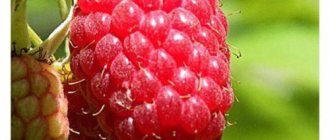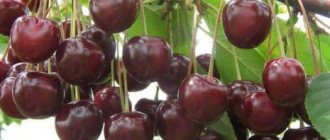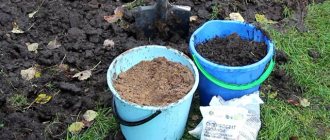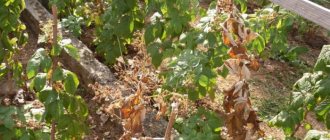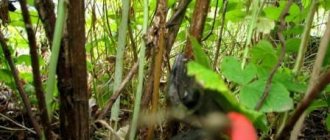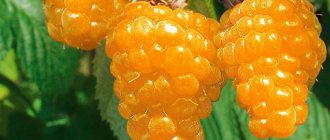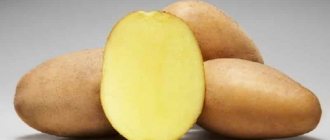Description and characteristics
The “Izobilnaya Kazakova” variety was developed by crossing the “Elizabeth Kip” and “Stolichnaya” varieties.
And already in 1991 it was included in the State Register. The bushes showed good frost resistance. Even frosts of -30 degrees did not damage the plant. On a note! “Abundant Kazakova” is a remontant raspberry, capable of bearing fruit on annual and biennial shoots.
The bushes of “Izobilnaya Kazakova” are compact and spreading. Capable of growing up to 2.5 m. There are no thorns. The shoots are thick and elastic, colored light brown with a whitish tint. The leaves are medium-sized, dark green, smooth.
The berries are large, standard in shape, and colored bright red. One ripe berry weighs 10 - 15 g. The skin is dense. When you tear off a berry, there is no trace left. Juicy and sweet.
Advantages of the variety “Abundant Kazakova”:
- Stable, annual yield;
- Large-fruited;
- Resistant to fungi and viruses;
- Marketable condition;
- Frost resistance;
- No thorns.
Disadvantages of the “Abundant Kazakova” variety:
- Does not like drought;
- Requires a garter.
Description of the variety
Raspberry Izobilnaya is a non-repairing, summer, large-fruited variety with a medium-early ripening period. The fruits begin to ripen from the beginning of July. Within a month, in 4-5 visits, you can collect up to 5-6 kg from a bush. high quality berries.
Abundant is considered a self-fertile raspberry, but if there are other varieties with early ripening on the site, the yield increases significantly.
You might be interested! Description of a promising variety with excellent survival rate and winter hardiness - Zhuravlik raspberry.
The bush is not very spreading; it produces 7-10 replacement shoots and 4-6 basal shoots per season. The shoots are powerful, durable, and by autumn they grow up to 2.5-3 m. At the base they have a waxy coating that turns higher into a felt covering. The color of young branches is light green, last year's shoots are red-brown. Internodes are shortened. A distinctive feature of Izobilnaya is the difference in thorns. Fruit branches grow on the shoots of the second year; they are branched, up to 30-40 cm long, flexible, each bears up to 30-40 berries. The fouling of the shoot with lateral branches begins from approximately 50-60 cm from the ground to the very top, this is due to the high yield of the variety.
The leaves of this raspberry are smooth, elongated, gray-green in color, with jagged edges. The leaf blades on the branches are located far from each other, so the bush is not thickened with green mass.
The berries are very large, the average fruit size of Izobilnaya reaches 9-14 grams; with intensive agricultural technology, the berries can weigh up to 16-18 grams. Raspberries are bright red in color, shiny, and have a regular conical shape. The drupes are one-dimensional, well pressed to each other.
The raspberry pulp is juicy, very sweet, but at the same time there is an expressive sourness in the taste, which gives Izobilnaya a specific, refreshing taste; pronounced berry aroma.
When picked, the berries do not flow or crumble. Harvested raspberries tolerate long-term transportation well.
It is important to note that the taste and commercial qualities of Izobilnaya raspberries largely depend on cultivation conditions, as well as on the weather. According to conflicting reviews from gardeners who grow this variety in different climatic zones, raspberries can be either sour, watery, or sweet, selective, and highly transportable.
Like all modern large-fruited varieties, Izobilnaya raspberries are not cultivated en masse, since many of the nuances of its cultivation have not yet been sufficiently studied. Gardeners do not have enough experience in determining at what combination of light, humidity, temperature, and soil characteristics the variety will be most productive.
Advantages of the variety
- high, regular yield;
- good taste and commercial characteristics of berries;
- raspberry resistance to most types of diseases and pests;
- high frost resistance;
- absence of thorns on the shoots;
- self-fertility of the variety.
Disadvantages of the variety
- tall shoots must be tied up;
- the strength of the shoots makes it difficult to bend them down for shelter;
- the need to cover bushes in regions with little snow in winters;
- the berries are baking in the sun.
- dependence of the taste and quality of the crop on climate and soil.
Landing
Despite the fact that the variety has shown resistance to many negative factors, it is necessary to follow the rules when planting. In order for raspberries to bear a lot of sweet and not watery-tasting fruits, make sure that the soil is not acidic, without adding fertilizers, and that there is no groundwater nearby.
When and where to plant
- Choose slightly acidic, neutral pH, light and fertile soils for planting;
- Plant shrubs along fences or walls, this will protect the raspberries from the winds;
- Sunlight should be in moderation; scorching rays will lead to drying of the plant and burns;
- It is permissible to plant raspberries in spring in April and autumn in September. In autumn, form holes for seedlings a month in advance. And in the spring, prepare the place in the fall.
Rules for choosing seedlings
- Purchase seedlings only from trusted places that seriously engage in the cultivation of varietal crops;
- Try to purchase annual or biennial plants;
- The planting material must have at least 2–4 shoots;
- Small seedlings are more viable;
- The shoots must be intact, without damage or dry areas;
- A healthy plant has a developed root;
- There must be at least 3 buds at the base. It is these buds that will produce fruit branches next year;
- Do not purchase plants with thin shoots, namely less than 1 cm;
Raspberry Izobilnaya Kazakova: variety description, planting, cultivation, care
The name Izobilnaya raspberry variety implies a fairly high yield, large fruit size, sweetness of the berries and ease of care. The stability of a high yield is guaranteed under very hot conditions in summer and fairly cold weather in winter.
The variety is often called Izobilnaya Kazakova, since the raspberries were bred by breeders Kazakov and Kichina by crossing a representative of the Stolichnaya variety with one of the British varieties - No. 39116/94. The variety is intended for temperate continental climates.
Description of the variety
Izobilnaya raspberry belongs to the remontant varieties and allows you to obtain harvests from both one-year and two-year-old shoots.
Bush
The bushes are semi-spreading, compact, height 2.5-3 m, thornless. Can form 10 shoots and 5 root shoots. The trunk is elastic, thick and light brown in color. The foliage has a rich dark green color.
Annual bushes are elastic, strong, covered with a felt coating, partially waxy in the lower part, internodes are shortened.
The strength of the shoots has its downside: they do not bend very well, and they may break when covered for the winter or when removed from the trellis.
Two-year-old raspberry seedlings Izobilnaya reach 3-3.5 cm in diameter, strong and powerful. There are at least 20-25 and up to 35-40 berries on the fruit branches.
Fruit
The berries are large, up to 12 grams, have a glossy surface and bright red color. One bush gives up to 8 kg of a full harvest.
The fruit has a dense structure and tolerates transportation well and does not lose its quality during storage in refrigerated chambers. Raspberries are used for consumption, both fresh and for preservation.
General characteristics
The variety is frost-resistant, withstands periodic frosts of -30 degrees. Ripening begins at the beginning of July and ends by the end of the month.
If the temperature is too low, there are cases of freezing of shoots up to 50 cm from the ground and freezing of the root system. Without shelter, a mild snowy winter with t -25C is not scary.
The high temperatures of the south are no less negative: the berries bake, and without shading and drip watering, adult plants and young raspberry seedlings may fall out.
Advantages of the variety
- High, regular yield;
- Good taste and commercial characteristics of berries;
- Raspberry resistance to most types of diseases and pests;
- High frost resistance;
- Lack of thorns on the shoots;
- Self-fertility.
More on the topic: Zeva variety of romanescent raspberry
Flaws
- Tall shoots must be tied up;
- The strength of the shoots makes it difficult to bend them down for shelter;
- The need to cover bushes in regions with little snow in winters;
- The berries are baked in the sun;
- The dependence of the taste and quality of the crop on climate and soil.
Soil preparation
Infertile soil in a raspberry patch will not be able to provide the shrub with sufficient opportunities for normal growth and fruiting. Deep digging of the soil and application of fertilizers is necessary. It should be organic and mineral complex.
The right choice of seedlings
For planting, it is best to purchase annual plants. There should be 2-4 shoots on the roots. The height of the bush should not be more than a meter. The root should be branched, and the trunk should not be damaged, without any foreign spots.
Selecting a site for planting
The area prepared for planting Izobilnaya seedlings must have a distance of more than 1.5 m to groundwater. If planting is done in the spring, then the land is prepared in the fall.
Raspberries do not like acidic soils; for this it is necessary to reduce the acidity level. This can be done by using lime or wood ash.
Raspberries of the Izobilnaya variety do not like piercing winds, so they need to be planted in a quiet place. This is a light-loving plant, but to avoid burns, the location should not be chosen in direct sunlight.
Disembarkation scheme
Planting can be done both in holes and in trenches. After the autumn preparation of the site, the specific holes or trenches for planting the crop are prepared. The earth taken out of the hole (trench) is mixed with organic matter and the addition of nitroammophosphate and wood ash.
A quarter of the mixed soil is poured into the bottom of the dug holes. The bush descends, but before that its roots are sprayed with the growth stimulator Kornevin and dipped in mash. The root is covered with earth, the hole is compacted, but not very much.
Then the planting is watered, one bucket of water per bush. The soil around the planting is mulched. For this, sawdust, rotted straw, and pine needles are used.
The dimensions of the holes and trenches are within 40/40/50 cm.
Loosening the soil and weeding
Loosening and mulching the soil is best done after each watering.
Weeding is carried out after they appear, and also in conjunction with loosening.
Disease control
Raspberry Abundant is resistant to many diseases, but additional prevention will not hurt it.
Anthracnose
Affects leaves and shoots. The reason is stagnation of water in the area where it is grown. Prevention includes reducing planting thickening and avoiding stagnation of water under plants.
To prevent the disease, spray with a 3% solution of Bordeaux mixture (400 g of quicklime, 300 g of copper sulfate per 10 liters of water).
What is needed: sufficient illumination of the bushes, soil drainage, combating stagnation of water under the bushes.
Powdery mildew
Both shoots and foliage are affected. To avoid its appearance, before buds open, the bush is treated with a 1% solution of copper sulfate.
Timely application of fertilizing containing phosphorus and calcium and mulching the soil with horse humus in the spring will help.
During flowering, twice with an interval of 14 days - treatment with Fitosporin (3 tsp per 10 l of water).
Root cancer
Leads to yellowing and premature falling of leaves and reduced yield. For preventive purposes against root cancer, before planting, a thorough examination of the roots and treatment of the root system with a 1% solution of copper sulfate (100 g of substance per 10 liters of water) is carried out.
Purple spot
Forms in the form of actively growing brown spots. Leads to a decrease in winter hardiness and death of the bush. 2 weeks before flowering, you need to spray the raspberries with Rubigan (4 ml per 10 liters of water).
More on the topic: Yellow remontant raspberry variety Morning Dew
It is also important to regularly loosen the soil and apply mulch, remove weeds and root growth.
Raspberry shoot aphid
It affects the inner surface of foliage and shoot tips. It sucks out nutrients, causing leaves to curl and die.
How to fight: before flowering begins (several times every 10 days), treat with one of the following solutions:
- Fufanon (10 ml per 10 liters of water),
- Fitosporin (3 tsp per 10 liters of water),
- Nitrafen (200 ml per 10 liters of water).
It is recommended to alternate medications.
And also: pruning and destruction of areas damaged by the pest, collecting aphid oviposition, spraying with a solution of baking soda (1 pack per 10 liters of water).
Raspberry beetle
It attacks fruits by feeding on them. Leads to a decrease in yield.
Every 2 weeks during the growing season (until the pest is destroyed) it should be sprayed with a solution of Karbofos (300 g per 10 liters of water) or Fitosporin. Along with this, the following is produced:
- Collection and destruction of fruits damaged by the pest.
- Digging the soil under the bushes.
- Regular removal of weeds between rows.
- Thinning raspberry bushes for air circulation.
Strawberry-raspberry weevil
It feeds on the inside of the buds, which causes them to dry out and fall off.
To cope with this pest, after buds open and before flowering begins, the bushes must be sprayed with a solution of Karbofos (300 g per 10 liters of water), damaged buds must be collected and destroyed.
Daily treatment with mustard tincture during the flowering period (200g per 10 liters of water) will also help.
Spider mite
Damages leaves by entangling them with cobwebs. Causes curling of leaf plates, drying out and death of the entire bush.
14 days before the start of flowering, spray with a solution of 1% colloidal sulfur (100 g per 10 liters of water), and treat with a four-day infusion of garlic (100 g of garlic per 1 bucket of water + 40 g of laundry soap).
Collecting and burning all fallen leaves in the fall.
Site preparation
It is best to prepare the site in late summer or early autumn. The soil needs to be deeply plowed, removing debris, roots of previous plants and weeds, and large clods must be broken up.
Add fertilizer. For 1 sq. m, it is enough to add no more than 10 kg of humus or compost. If the soil has high acidity, then it can be reduced with wood ash per 1 square meter. m add 0.5 kg.
Raspberries can be planted either in holes or in a pre-prepared trench. If the soil is a little dry, you can lightly sprinkle it with water.
Step by step process for beginners
- Into pre-made holes measuring 40x40x50 cm, or a prepared trench, add fertile soil at the rate of 9 kg of humus + 100 g of potassium sulfate + 200 g of superphosphate. Build the soil in the form of small slides. It is necessary to maintain a distance between plantings of 1 m, and place row spacing 1.5 m from each other.
- Dip the roots of the seedlings in the mullein solution. Straighten and cover with a small layer of soil. In this case, the root collar should be located at a distance of 3–4 cm from the ground surface.
- Place a trellis over the entire planting. Drive in pegs 2 m - 3 m high at a distance of 1 m from each other, stretching the metal wire into several rows, gradually increasing, starting from 75 cm and higher from the ground.
- Each bush must be watered with 7–10 liters of water. Loosen the soil and mulch with peat.
- To speed up the growth of side shoots, pinch the tops as soon as the seedlings reach 1 m in height.
OLYMPUS DIGITAL CAMERA
Thornless raspberry variety Izobilnaya
The culture of Russian selection was obtained by crossing domestic varieties with English seedlings. Mid-early raspberries begin to ripen in early July. The name corresponds to the description: the variety’s yield is 4.5 kg per bush.
Appearance, size and type of berries, fruiting period
The height of the bush reaches 2.5–2.8 m, the stems are strong, without thorns, and covered with soft pile. In adult bushes, during the dormant period, the shoots acquire a red tint. The semi-spreading crown has medium foliage, the foliage color is gray-green.
How to prune indoor hibiscus correctly? Let's give the Chinese rose shape!
At the beginning of June the bush blooms, and within a month it bears fruit. The berries are large, weighing up to 12 g, and have an elongated oval shape. The color of the berries is bright red, the pulp is homogeneous and has a dense structure.
Large-fruited raspberries are famous for their dessert-sweet taste with a slight hint of sourness, as well as a bright raspberry aroma. I am pleased with the extended fruiting period - until August inclusive.
Advantages and disadvantages of the variety
- In addition to early ripening and the absence of thorns, the variety has other advantages:
- despite the rapid growth of shoots, the bush retains its compact shape;
- the crown is not too thick, which ensures uniform heat flow to all the berries;
- large fruit size and excellent taste;
- versatility in application;
- high yield, up to 5 kg per bush;
- resistance to viral and fungal infections.
- However, raspberries also have significant disadvantages:
- when frosts are above -25°C and there is little snowfall, you need good shelter;
- Tall shoots bend from an abundant harvest, so support is required when growing;
- lignified shoots of adult bushes do not bend well under shelter for the winter;
- in intense heat when the temperature rises to +30...+35°C, the berries are dried in the sun.
Trimming
Thin raspberries in early spring before sap begins to flow. When trimming, on each square. m leave 10 - 15 strong shoots. The sanitary pruning procedure should be applied to frozen or dry branches and weak growth. Lubricate the cut areas with garden varnish to prevent infection.
Remove branches that bore fruit last year, leaving no stump. But the tops of young shoots should be pinched for accelerated development.
You may be interested in: How to feed raspberries in the fall for a good harvest. How to prune raspberries in the fall for a good harvest. Pruning remontant raspberries: how to do it correctly
How to care?
In order for seedlings to quickly adapt to growing conditions and begin to develop, it is necessary to provide adequate care.
Watering
When watering Izobilnaya raspberries, it is important to maintain a balance: overdrying and overmoistening the root system are equally dangerous for the plant. The next portion of water is poured under the bushes after the top layer of soil has dried.
The frequency of watering depends on the air temperature:
- in hot weather - once every 2 days;
- in cool weather - once every 7 days;
- in the presence of periodic rains - depends on the condition of the soil: wet or dry.
Top dressing
Regular application of fertilizers ensures proper development of the plant and increases productivity. The composition of the fertilizer depends on the stage of raspberry development:
- In spring, branches need stimulation to grow green mass, so the main element of fertilizing is nitrogen. 150 g of ammonium nitrate per 1 square meter is scattered under the plant and embedded in the soil.
- Before flowering and during fruit set, raspberries need potassium and phosphorus. Fertilizing is carried out with universal mineral mixtures.
- In the autumn, to restore strength after fruiting, the plant is fed with organic matter: 1 kg of manure or bird droppings per bucket of water.
Important! If, when planting a seedling, the pit was properly filled with organic matter and mineral fertilizers, no additional fertilizing is carried out in the 1st and 2nd years.
Trimming
During the entire growing season, bushes need to be pruned 3 times:
- In early spring, before the start of sap flow processes, thinning pruning is carried out. For every square meter of raspberry planting, 13-15 of the most developed shoots should remain. The remaining branches are cut off at the root. After the procedure, the cut areas are covered with garden varnish.
- In summer, after annual shoots reach a height of 150 cm, the crown is pinched. This technique stimulates the formation of many side shoots on which berries will form.
- In the fall, unripe, damaged shoots are removed. Branches are cut at the age of 3 years.
Wintering
Without additional shelter, raspberry bushes can survive the winter only if the snow cover is at least 100-150 cm deep. In winters with little snow, the shoots can freeze at temperatures below -20 degrees. To protect the shoots from freezing, raspberry bushes need careful shelter.
Warming is carried out as follows:
- At the end of September, before the shoots lose their flexibility, they are tied in bunches and bent down.
- The bunches are fixed at a height of 20 cm from the soil using wooden or metal brackets.
- After the onset of stable frosts below -5 degrees, the shoots are covered with geotextiles, spruce branches or roofing felt.
Advice! Roots are protected from freezing by mulching. Humus mixed with sawdust is suitable for this. The mulch layer should be at least 8 cm.
Protection from diseases and pests
The variety is resistant to diseases common to this crop, but if the rules of agricultural technology are violated or in unfavorable weather, the following problems may arise:
- Anthracnose is a fungal disease caused by waterlogging of the soil. A sign of infection is bluish-purple spots on the leaves with a burgundy border. For treatment, the bush is sprayed with Bordeaux mixture at a concentration of 3%.
- Root cancer - growths form on the roots. To prevent the development of the disease, the roots of the seedling are treated with copper sulfate, then dipped in clay mash.
- Powdery mildew is a fungal disease that develops in damp, cool weather. The bush is covered with a whitish or grayish, powder-like coating. Spores are destroyed with the drugs Ridomil Gold, Fitosporin, Profit Gold.
- Purple spot - the fungus forms brown spots on shoots and leaves. Spraying with Rubigan helps to cope with the disease.
In addition to diseases, raspberries are dangerously attacked by insect pests:
- shoot raspberry aphid;
- raspberry beetle;
- strawberry-raspberry weevil;
- spider mite.
Before flowering begins, insect control is carried out by treating with insecticides: Karbofos, Aktara, Alatar, Fitoverm.
Top dressing
Fertilizers help the seedling grow and develop, as well as produce a good harvest. If you regularly add them, the plant will be provided with strong immunity and protection from negative influences.
You can apply such fertilizers per 1 square meter. m:
- Add 4.5 kg of humus or peat when digging in the autumn;
- 150 g of urea or ammonium nitrate when digging in the fall;
- Place 1 kg of mullein or chicken manure in a bucket of water around the trunk in April;
- 200 g of wood ash when digging in the autumn;
- Apply cow or horse manure under the bush in June in a layer of 5–6 cm.
Diseases and pests
The Izobilnaya variety is quite resistant to many common raspberry diseases. However, in order to prevent diseases, as well as to minimize harm from attacks by insect pests, it is necessary to carry out procedures for treating shrubs in a timely manner.
Raspberry diseases and ways to combat them - table
- Sufficient illumination of the bushes.
- Soil drainage.
- Fighting stagnation of water under bushes.
- Timely application of fertilizers containing phosphorus and calcium.
- Mulching the soil with horse humus in the spring.
- Regular loosening of the soil and application of mulch.
- Cleaning of weeds and root shoots.
How to recognize the disease - photo gallery
Raspberry pests and ways to combat them - table
- Pruning and destruction of areas damaged by the pest.
- Collection of aphid ovipositions.
- Spraying with a solution of baking soda (1 pack per 10 liters of water).
- Collection and destruction of fruits damaged by the pest.
- Digging the soil under the bushes.
- Regular removal of weeds between rows.
- Thinning raspberry bushes for air circulation.
- After the buds open;
- before flowering begins.
- Collection and destruction of damaged buds.
- Daily treatment with mustard tincture during the flowering period (200g per 10 liters of water).
- Treatment with a four-day infusion of garlic (100 g of garlic per 1 bucket of water + 40 g of laundry soap).
- Collecting and burning all fallen leaves in the fall.
Harmful insects in the photo
Winter shelter
Although “Abundant Kazakova” has been shown to be frost-resistant, the root system may not be able to cope with temperature changes in late winter. To prevent weakening of the roots, covering with agrofibre or spruce branches is sufficient. Mulch can provide additional protection. It can be made from horse or cow manure with the addition of sawdust, placed on the tree trunk circles in a small layer of no more than 7 cm.
On a note! Don’t forget to remove the bushes from the trellis, pull the branches into a bunch and bend them to the ground, and only then cover them.
Don't do this too early, otherwise the bushes may dry out in autumn temperatures. And such plants, having reached frost, will weaken and become fragile. Therefore, the optimal time is after the leaves fall, before the first frost.
Plant care
In order for raspberries to quickly enter the growth phase and begin to actively develop, they need to be provided with proper care. It includes not only regular watering and pruning, but also the application of fertilizers to improve the quality of the crop, as well as protection from diseases and pests using homemade tinctures or industrial products.
Trimming
It is recommended to thin out raspberries in early spring - before the sap begins to flow. On each square meter, when pruning, it is necessary to leave about 13–15 strong and strong shoots.
Dry, broken, frostbitten branches and underdeveloped shoots are subject to sanitary pruning.
The procedure is carried out with a sharp knife or garden pruning shears, and the cut areas are treated with garden varnish to avoid the entry of pathogenic bacteria.
To increase the yield of raspberries in the summer, when the annual stems reach a length of approximately 1.5 m, it is recommended to pinch them
Last year's branches that bear fruit are cut off at the root, without leaving stumps, and the tops of young shoots are pinched, which gives them an impetus to faster ripening.
How to prune raspberries correctly - video
Watering
Raspberries of the Izobilnaya variety love water very much, but do not tolerate its excess.
The best way to water raspberries is by sprinkling. This method saturates the bush with moisture, making it easier to tolerate the heat.
Regular watering is especially important during the fruiting period. One raspberry bush needs 2-4 buckets of water. It is recommended to water in the morning or evening.
You should avoid excessive puddles and stagnant water under the bushes, and also try to maintain soil moisture at the same level, increasing the amount of watering in dry weather and reducing it in frequent rainfall.
Top dressing
Fertilizers play a major role in the growth and development of seedlings, and are also responsible for the future harvest. Regular application of fertilizing will provide the plant with good immunity and create additional protection from harmful environmental influences.
Fertilizer application schedule - table
Shelter for the winter
Raspberries of the Izobilnaya variety are able to withstand frosts down to -30 o C. However, quite often the root system cannot cope with temperature fluctuations in late winter, so for reliability it is recommended to cover the bushes with spruce branches or special agrofibre. In addition, additional protection from freezing of the roots is the introduction of mulch (horse humus with sawdust in a layer of 6–8 cm around the tree trunk).
Before covering the bushes, they are removed from the trellis, the branches are pulled into one bunch and carefully bent to the ground.
If you bend the plants to the ground too early, they can wither when autumn temperatures are still quite high, and if you wait until frost, the shoots become fragile and can be damaged when tilted, so the optimal period for performing the procedure is considered to be the time after the leaves have fallen, but before the first frost
Harvesting and storage
The first harvest can begin to be harvested in early July. From one bush - 7.5 kg. The ripening of the entire crop is uniform and you can pick ripe raspberries throughout the summer.
Stores for 4 – 5 days in the refrigerator. It is better to place the raspberries in a dry container and do not place any products with a strong smell next to them.
The berries have a dense structure and therefore withstand transportation while maintaining their appearance. They can be used fresh to decorate dishes, as well as for preparing seasonal preparations.
Main characteristics
The flowers are small in size, collected in racemose inflorescences, each of which can form a large number of ovaries.
At least 30 berries can ripen on each fruit branch. The fruits are very large, their shape is conical, elongated, with blunt tips. The weight of ripe berries can reach 13-15 g; with proper care, their weight can be up to 18 g. The color of ripe shiny fruits is a rich ruby color.
Photos of growing Izobilnaya raspberries
The drupes are tightly fastened together, so the berries do not crumble during the ripening process, and they tolerate transportation well at any distance without releasing juice.
The pulp of the fruits of this variety contains a large amount of sugars, so their taste is very sweet, but with a characteristic sourness. The aroma of ripe Izobilnaya raspberries is distinctly fruity.
But the taste and marketability of the ripening fruits of the Izobilnaya variety largely depend on the climatic conditions of the growing region
– dry or rainy periods, depending on which the berries may be watery or sour.
Reviews
Amalia: My raspberries have grown very tall, almost 3 meters, and the side shoots are 1.5 meters, but on old shoots, not on young ones. Previously, by mistake, we placed it in a sunny place, and the berry was boiled and was no good, but now we placed it in the shade and no longer observed such consequences. It is stored normally, the appearance has not deteriorated during transportation from village to city.
Valeria: We have been growing only this for five years now. We didn't have any problems with it. It grows well and produces a large harvest. Withstood severe frosts. It reproduces faster than neighboring bushes. The purpose, I would say, is dessert. Children eat it with ice cream. In general, we liked the variety from all sides. Therefore, I can confidently recommend the variety to everyone. Try it!
Advantages and disadvantages
The main advantages of the Izobilnaya raspberry variety include:
- good yield;
- ripe berries have a wonderful taste and wonderful appearance;
- resistance to most diseases and attacks by “harmful” bugs;
- high frost resistance;
- there are no thorns on the stems;
- the variety is self-fertile.
Experts include the main disadvantages of this raspberry
:
- the need to tie shoots to trellises;
- the stems are too strong, so it is difficult to bend them to the ground when covering for the winter;
- in regions with cold winters and little snow cover, this variety must be covered for the winter;
- when grown in bright sunlight, the fruits may bake;
- taste and yield depend on climatic conditions and soil composition.
